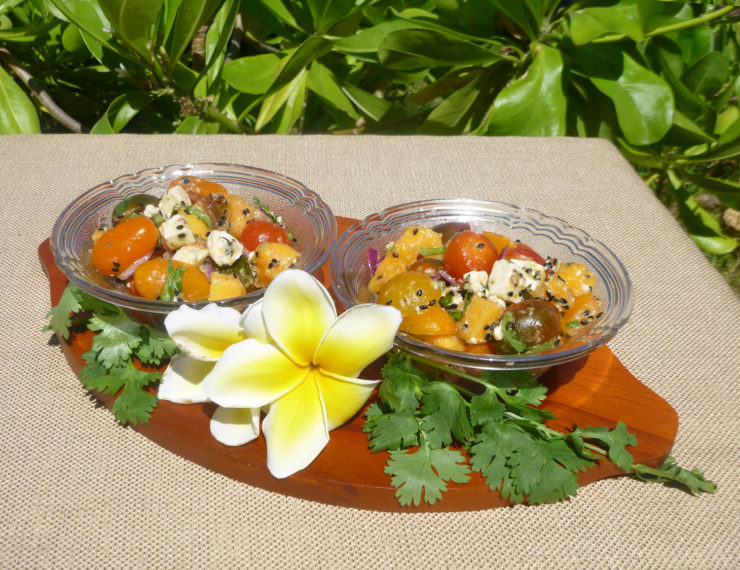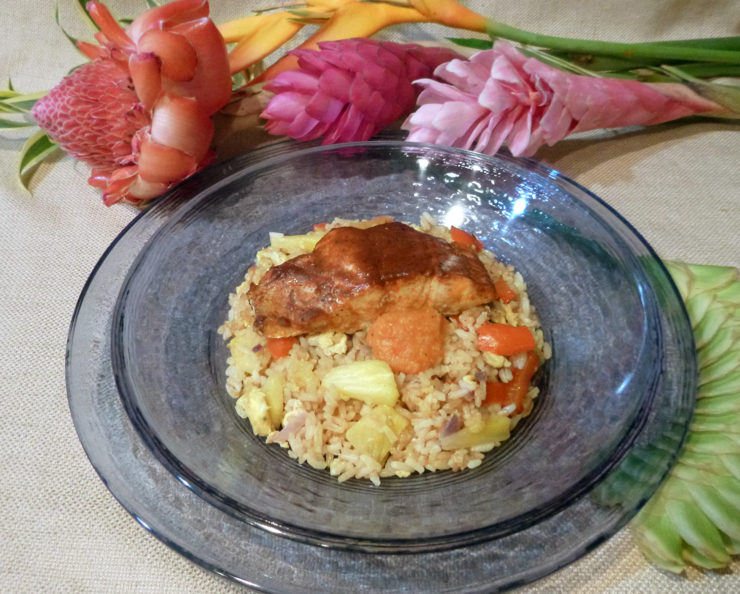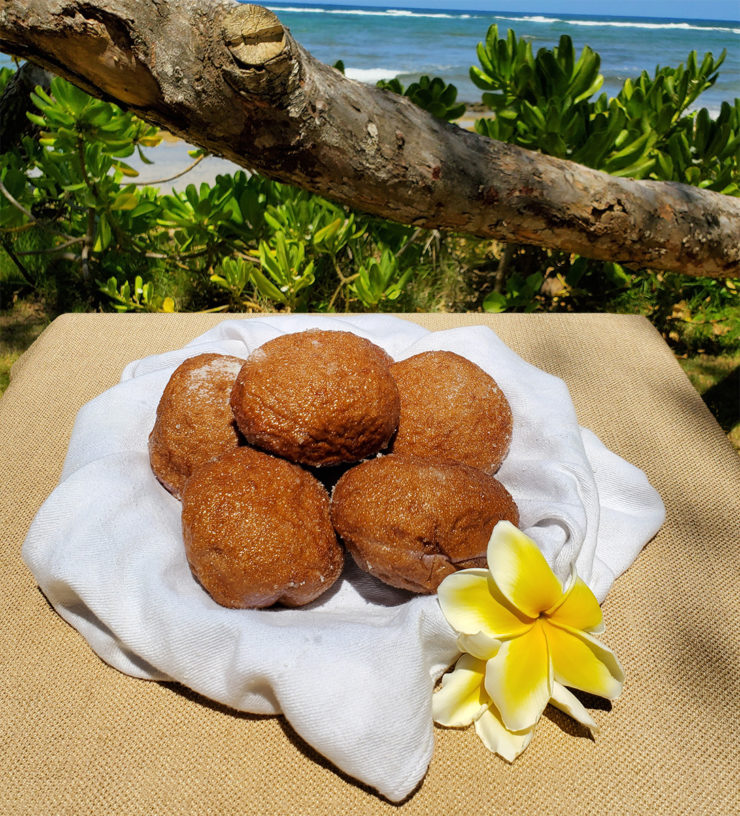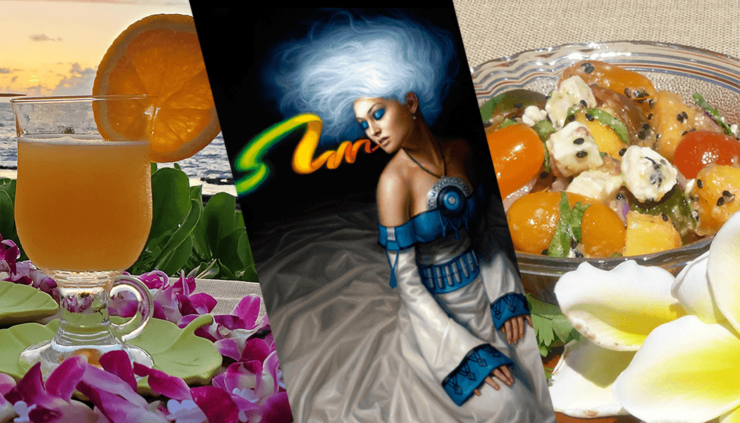Welcome as we continue to travel along the Cosmere Cuisine road! In this installment, we’re journeying to Nalthis in honor of Warbreaker’s 10th anniversary of publication. Endowment’s world is one of the most colorful planets created by Brandon Sanderson to date. From the highlands of Idris to the seashores of Hallandren, a richness of color infuses the world. The people of Hallandren celebrate the beauty, colors, and the richness brought to them by the Tears of Edgli.
Warbreaker leaves me with the impression of food in abundance. Food is discussed more than in any other Sanderson series besides The Stormlight Archive. I always become hungry when reading the story—typically for some seafood, since I’m not Idrian.
The colorful world of Nalthis was inspired, in part, by Sanderson’s honeymoon trip to Hawaii. Along with the exotic fruits, abundant seafood, and mild climate, it’s an unusual and refreshing setting for a fantasy story. Having just enjoyed my own birthday trip to the island of Kauai, I can appreciate Sanderson’s sense of inspiration. I’ve drawn on Hawaiian cuisine in creating these recipes but have made them with ingredients accessible back on the mainland of the United States. Regional Hawaiian food is shaped by the cultures that settled the islands, including Polynesian, Portuguese, Japanese, and Chinese, among others. Our Hallandren foods will pull from all these influences.
Buy the Book


Warbreaker
In the story, there are numerous examples of dishes with raw seafood preparations, such as the oysters that make Vivenna shudder. Personally, I find it easiest to enjoy the best raw seafood by visiting the local oyster bar, sushi, or poke restaurants. For recipes to share, my focus was on cooked items mentioned in the book. Details on finished dishes in the novel were more scant than I remembered, yet there are enough ideas to generate a tasty meal.
During one meeting, Tonk Fah eats a basket of “fried things,” according to Vivenna. This means we can enjoy a basket of fish and chips or fried calamari as Hallandren food! Assuming you do not share the Idrian aversion to seafood, that is. In the novel, Siri learns to appreciate most of it, while Vivenna retains her dislike of the seafood, even as she eats it—much like the sisters’ responses to the colors in T’Telir. Speaking of colors, the Hallandren love of color would extend into their food choices. We all eat with our eyes first, but I believe they would take it an extra step to ensure their foods incorporate as many colors as possible in each dish. This could be another small way in which they honor the Iridescent Tones.
One key difference between Hallandren and Hawaiian cuisine is the use of pork in the cultures. While pork is a major protein in Hawaiian cuisine, it does not seem to be a factor in the Hallandren diet; instead, the focus is on various seafoods, fruits, and grains. Indeed, pigs are never mentioned in the book, while cows are only referenced once. According to Siri, the Idrians raise geese, goats, and sheep in their highlands. This suggests that most milk products are goat milk-based, not cow milk-based—great news for lovers of feta cheese!
As with Scadrial, the foods of Nalthis seem to be very Earth-like. For simplicity, we will assume if it can grow in a tropical region, it can be found in Hallandren. If the food comes from other types of environments, it would be made available via trade along the inner sea.
Fruit Juices

Lightsong enjoyed many fruits in the book, but it seemed he enjoyed grapes above all others. The list of fruits that grow in the tropics is long, and the juice combinations are practically endless. As we see in Warbreaker, both sisters from the beginning appreciate the fruits and juices served. Juices are the appropriate beginning for our food journey on Nalthis.
If you are lucky enough to have access to all these fruits whole, enjoy the added freshness that comes from juicing them yourself. If you can only access pre-made juices or concentrates, the flavor combinations are still a burst of fruity goodness. Serve the drinks in chilled glasses and slowly sip to enjoy the refreshment.
Classic P.O.G. Juice (Passion Fruit-Orange-Guava)
Passion fruit-Orange-Guava (P.O.G.) juice can be found pre-mixed across Hawaii. This drink is tart, mildly sweet, citrusy, and refreshing. The flavor combination is a local favorite found in many desserts, not just as a drink. Once you try it, you’ll understand its wide appeal.
I think the passion fruit and its juice will be the hardest to find outside of a growing zone. Fresh passion fruit can be expensive, but its flavor really is worth the extra effort. The type you find will also determine how much juice you get from one fruit, since some are juicier than other varieties. In Hawaii, it is called liliko’i, and while the passion fruit flavoring and juice is abundant, I found the fruit itself hard to locate on the island for sale. Same with guava: different types come in different colors, sizes, and availability. If you have not juiced any of the fruits used, please search for a few tutorials about how to do so before you start cutting into them.
These recipes are on a scale of small batches; scale up as needed.
Ingredients
- Passion fruits — 4 to 6 fruits or ½ cup of juice
- Guavas — 1 large or 3 small fruits or 1 cup of puree
- Oranges — 2 fruits or 1 cup of juice
- Water
Directions (1 Part = ½ cup)
- Juice the passion fruit directly into a blender. Add ¼ cup of water to help it blend. Strain the mixture to remove the seed particles into an airtight container. Set in fridge to cool.
- Skin and dice the guava fruits. Use a blender to puree them. Add ¼ cup of water to the blend to aid the process. Strain the mixture to remove most of the seed particles, if too thick, blend again with another ¼ cup of water. Will be baby food-like in texture. Set in fridge to cool.
- Cut the orange in half, use a juicer to collect fresh-squeezed juice.
- Add 1 part passion fruit juice to 2 parts guava puree, 1 part orange juice, and 1 part water. Blend until smooth.
- For extra tartness, add more passion fruit. For more sweetness, add more orange juice.
- Chill, then serve in a chilled glass with a fruit accent and enjoy.
Tropical Joy (Papaya, Pineapple, and Coconut Juice)
This juice combines three very popular tropical fruits. It makes more of a fruit smoothie than a true juice drink. If you want to enhance the coconut flavor, add fresh coconut to the blender. Using just the coconut water gives a hint of the flavor but lets the papaya and pineapple flavors stand out. This drink is sweeter than the P.O.G. juice and people should find the components easier to find in most locations.
Ingredients
- 2 cups fresh pineapple — peeled and cored
- 2 cups fresh papaya — seeded and cubed
- Pineapple juice
- Coconut water
- Lime juice
Directions (1 Part = ½ cup)
- Peel and cut the pineapple into small cubes.
- Peel and cut the papaya into small cubes.
- In a blender add 2 parts papaya, 1 part fresh pineapple, and 2 parts pineapple juice. Blend until chunky.
- Add 1 part coconut water and 1/4 part lime juice (about 2 tablespoons), blend again until smooth.
- Chill, then serve in a chilled glass with fruit accents and enjoy.
Side Dish

Papaya-Tomato Salad
This side dish celebrates the Hallandren love of color, along with their access to fresh vegetables and fruit year round. There are mentions of vegetable dishes, but no details in the story. The ingredients incorporate ones used in other dishes I created for the article. The acid of the tomatoes contrasts well with the creamy saltiness of the feta cheese, while the sesame seeds provide a textural contrast.
Ingredients
- 1 large papaya or 2 small ones — seeded and cubed
- 1 pint cherry or grape tomatoes — heirloom color mix — halved
- 1 orange tomato — diced
- ⅓ cup of red onion, thinly sliced
- 1/4 cup fresh cilantro, chopped finely
- 1/2 cup feta cheese — crumbled
- 1 tablespoon black sesame seeds
- ¼ cup extra virgin olive oil
- Salt & pepper to taste
Directions
- In a dry skillet, toast the sesame seeds until fragrant, 2-3 minutes. Set aside to cool.
- Cut up the tomatoes: slice the cherry tomatoes in half, dice the large orange tomato.
- Cut the papaya into half-inch cubes, similar in size to the orange tomato. You want 1 cup of diced papaya.
- Finely slice the onion and cilantro.
- Combine all tomatoes, papaya, onions, and feta* cheese together in a serving dish.
- Add the olive oil, chives, and toasted seeds. Stir to mix well.
- Cover with clear wrap, let salad sit in the fridge for an hour to let the flavors meld before serving.
*Note: If you don’t like feta cheese, you can replace it with bocconcini. Mozzarella cheese can be made with goat’s milk, it is just harder to find in the stores.
Main Dish

Tektees Spicy & Sweet Fried Rice
Vasher eats Tektees spicy rice while meeting with Bebid, priest of Brightvision. We learn nothing else of the Tektee people or culture besides this dish, which tells readers the spices used are foreign to Hallandren, yet popular. This seemed the perfect dish to turn into a fried rice, which is easy to adjust according to your personal spice level. Enjoy it on its own, as Vasher does, or add a protein of choice on top, as I did in the photo above.
Ingredients
- 2 cups uncooked rice (10-minute rice)
- 1–1/2 cups chicken broth
- 1/2 cup of orange juice
- 1 tablespoon toasted sesame oil
- 1-inch piece of fresh ginger — grated
- 2 cups vegetable oil
- 1/2 cup red onion finely chopped
- 1 medium red bell pepper cut into 1/4-inch dice
- 3 cloves garlic finely chopped
- 1 egg, beaten
- 1 cup fresh pineapple cut into 1/4-inch dice
- 3 tablespoons soy or fish sauce
- Cayenne pepper to taste — optional
NOTE: If your pan is not large enough to fry all the rice at once split your loose ingredients into two piles and work in smaller batches. Adjust the rice proportions below accordingly. This is also a good way to make one sweet batch and one spicy batch of rice, if your family dynamic is like mine, and some don’t want spicy. Make your non-spicy option first to avoid having to clean your pan between batches.
Directions
- Peel and grate the ginger or cut it very finely. Mash the pieces to release extra juices.
- Mix the chicken broth, orange juice, and sesame oil in a 6-quart pot. Add the ginger pieces. Add 2 cups of rice. Bring to a boil. Then cover and let simmer for 10 minutes. When done, remove from heat and fluff.
- Cut and prep the onions, garlic, bell peppers, and pineapple while the rice cooks.
- If you like bell peppers and onions to have a softer texture, roast them in a skillet for 5 minutes in advance. You will cook them again with the rice.
- If you want the pineapple to be sweeter, roasting the pieces enhances their taste. Roast for 5 to 10 minutes in a grill pan prior to cooking the rice.
- Heat a wok or large pan to a high heat and add about 1/3 of the rice along with about 1 tablespoon of vegetable oil. Stir fry for about 2 minutes, tossing constantly with a spatula.
- Make a well in the center of the rice, add a teaspoon of vegetable oil, then add the onion, bell pepper, and garlic. Continue cooking for another 2 to 3 minutes until the onion is soft and translucent and combined with the rice thoroughly.
- Add another ⅓ of the rice, stirring it constantly for about 3 minutes.
- Again, make a well in the center of the rice and add the egg. Cook until set, scramble and distribute throughout the rice. (If working in smaller batches, you can pour in half an egg, or use one full egg per batch)
- Add the remaining rice, stirring for about 2 minutes
- Stir in the pineapple, soy (or fish) sauce, and Cayenne pepper (if desired); mix thoroughly while cooking another 2 minutes. Serve rice warm.
Hallandren Grilled Fish with Roasted Pineapple Sauce
Cooked fish dishes are mentioned multiple times by Vivenna and Siri. I decided to use a mild fish with a strong marinade in order to make this dish more appealing to people who do not favor a strong fish flavor. The roasted pineapple sauce adds a punch of sweet heat with its bright orange color. It also creates a nice contrast to the deep red of the paprika marinade.
For this dish, some Hawaiian fishes you could chose are mahi-mahi, ono (wahoo), or hapu’upu’u (sea bass). Ask your fishmonger for the best recommendation based on their selection. I’d suggest one with a mild natural flavor, white flesh, and a thin skin. I used Pacific and Gulf Coast snapper, and they were delicious.
Ingredients for Roasted Pineapple Sauce
- 2 cups peeled and cored fresh pineapple
- 1 red bell pepper, quartered and seeded
- 2 tablespoons fresh lime juice
- ½ teaspoon salt
- 1 teaspoon freshly ground black pepper
- Cayenne pepper to taste — at least ¼ teaspoon
Sauce Directions
- In a grill pan, sear and soften the pineapple and red bell pepper, turning occasionally with tongs.
- Once roasted, cut the bell pepper and pineapple into smaller pieces to help it blend easily.
- Transfer the pineapple and bell pepper to a blender; add salt, black pepper, cayenne pepper, and lime juice — puree the mixture until slightly chunky.
- Keep the sauce warm to room temperature, until fish is ready to serve.
Ingredients for Fish
- 4 fish fillets (about 1.5 to 2 pounds of fish)
- 1 tablespoon sweet paprika
- 3 tablespoons canola oil
- 3 tablespoons fresh lime juice
- ½ teaspoon salt
- 1 teaspoon freshly ground black pepper
Fish Directions
- Create the marinade by combining the sweet paprika, salt, pepper, oil and lime juice in a bowl. Coat the fish fillets thoroughly with the marinade. Cover and let marinade for at least 30 minutes before cooking.
- Preheat grill to high. IF you do not have a grill, bake fully with an oven broiler.
- Grill the fish until opaque; it should be turned at least once. Time will depend on how thick the fish is cut, about 5 to 10 minutes.
- If the grill does not cook the thicker cuts of the fish fully, finish with a few minutes under the broiler.
- Serve with the roasted sauce over Tektees rice, or with a side salad.
Dessert

Pahn Kahl Sweet Bread — Malasadas
Siri and Susebron both enjoy a sweet treat during their nighttime feast. Susebron says the Pahn Kahl sweet bread should be enjoyed one bite at a time…while Siri just shoves a whole one in her mouth, showing him how to disobey one more rule.
I am declaring malasadas to be our world’s version of Phan Kahl sweet breads. These are a type of Portuguese doughnut coated in sugar that are very popular in Hawaii. Traditionally they have no filling. One popular Hawaiian variation includes using taro root flour and a sweet bean paste filling. The fluffy sweetness is a delightful bite; enjoy them as you wish.
My recipe varies from traditional malasadas by using an orange citrus sugar in both the cooking and coating process. It adds an extra fruit note to the bread.
Ingredients (Makes around 18)
- 1 tablespoon rapid rise yeast
- 1/4 cup warm water
- 1 1/2 cup sugar
- 1 orange, zested
- 1 lemon, zested
- 1 cup evaporated milk
- 1/2 teaspoon cinnamon
- ¼ teaspoon salt
- 2 tablespoons butter, melted
- 3 eggs, room temperature
- 4 cups flour, sifted
- Vegetable oil for frying
- Powdered sugar for sprinkling
Directions
- Sift the flour. Set to the side.
- Zest the orange. Zest the lemon.
- Use a food processor to mix sugar with the orange and lemon zest to create orange citrus sugar. Set to the side.
- Mix the yeast with warm water and 1 tablespoon sugar to start it blooming for 10 minutes.
- Beat eggs until fluffy, using a flat beater on a stand mixer.
- Mix melted butter, evaporated milk, cinnamon, 1/2 cup sugar, and salt into the beaten eggs.
- Add yeast mix to other wet ingredients. Mix well.
- Slowly add the sifted flour to the mix, beat until dough is smooth.
- Lightly cover dough in oil. Set it aside in a warm area for 1 hour to rise. The dough should double in size.
- On a lightly floured surface, roll dough into a 12” square, about ½” thick. Cut dough into 2” squares.
- Placed on parchment paper at least 3” apart, cover in plastic wrap. Let rest in warm area to rise again for 1 hour.
- Heat at least 2” of vegetable oil in a 6-qt pot to 375-degrees Fahrenheit.
- Work in batches to fry the malasadras. They should puff up while cooking. Cook for 2 minutes per side. Flip once. Look for a dark golden-brown color.
- Transfer to a wire rack to cool completely.
- Toss them in the remaining orange citrus sugar.
- Dust with extra powdered sugar, serve that day.
On this sweet breath, we end our tour of Nalthian foods. I’m sorry we did not explore the Idrian food for those that were hoping for highland dishes; I suggest looking up some Scottish goat recipes for inspiration. Mab the cook is an interesting character, if you read the annotations, but I was not inspired to recreate her soup. For now, let us enjoy the fruits and flavors given to us while exploring T’Telir. We bid farewell to Nalthis until Warbreaker 2 is written in the distant future. Go forth and eat some grapes in honor of Lightsong!
Deana Whitney is a foodie, researcher, and Sanderson beta reader. Her 40th birthday trip to Kauai, Hawaii was a happy accident of timing for researching the foods of Nalthis. She wants to go back to explore more of the islands and the foods. She also now thinks more things should be made with taro root flour. Poi is fine, but purple bread is awesome.










